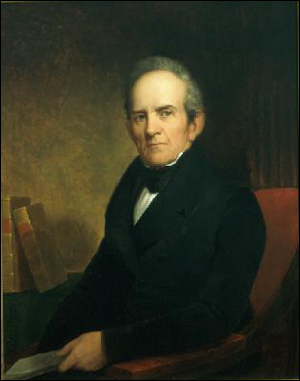1768-1843
Associate Justice of the New York Supreme Court, 1802-1814
Chief Justice of New York, 1814-1818
Born on January 17, 1768 in Stanford, Dutchess County, NY, Smith Thompson was a nephew of the leading anti-federalist, Melancton Smith. Thompson graduated from Princeton University in 1788 and then studied law in the office of James Kent and Gilbert Livingston. Admitted to the bar in 1792, he set up a law practice, first in Troy, and then in Poughkeepsie. In 1800, he was elected a member of the State Legislature, and the following year was a delegate from Dutchess County to the Constitutional Convention of the State of New York.
On January 8, 1802, Smith Thompson was appointed an Associate Justice of the New York Supreme Court of Judicature and, on February 25, 1814, he became Chief Justice of New York, replacing James Kent, who had been appointed Chancellor of New York. During his 16 years on the New York Supreme Court, Judge Thompson wrote approximately 250 opinions and frequently joined in Justice Kent’s opinions such as those in the John Van Ness cases (1809-1811), People v. Croswell (1804) and People v. Ruggles. In a child custody case that still resonates today, Justice Thomson looked to the best interests of the child and, in his majority opinion in In re Waldron,(13 Johns. 418 N.Y. Sup. [1816]), declined to transfer custody of a young child from her maternal grandfather to her father, stating: “It is to the benefit and welfare of the infant to which the attention of the Court ought principally to be directed.”
In 1818, President James Monroe appointed Smith Thompson Secretary of the Navy with responsibility for enforcing the prohibition of the international slave trade. The USS Smith Thompson (DD-212) was a Clemson-class destroyer in the United States Navy that was named for Smith Thompson.
In 1823, Monroe appointed Thompson to the Supreme Court of the United States where he succeeded Justice Brockholst Livingston. Justice Thompson was assigned circuit duties in the Second Circuit, which consisted of New York, Connecticut, and Vermont, and thus he was involved in three separate stages of the Amistad case as it passed through the federal court system — presiding over the brief hearing of criminal charges directed against the Amistad captives in September 1839, the abolitionists’ appeal for release of the Mende under a writ of habeas corpus, and in the United States Supreme Court when he joined in Justice Story’s opinion. In his dissenting opinion in Cherokee Nation v. Georgia (30 U.S. 1 [1831]), Justice Thompson stated that “despite their weakened status, the Cherokee constituted an independent sovereign nation.” A supporter of states’ rights, Justice Thompson often opposed Chief Justice John Marshall’s federalism.
Justice Thompson received the degree of LL. D. from Yale and Princeton in 1824, and from Harvard in 1835. He remained on the Supreme Court bench until his death in Poughkeepsie, New York on December 18, 1843.
Sources
Charles Elliott Fitch. Encyclopedia of biography of New York, vol. 1.
Herbert A. Johnson. The Chief Justiceship of John Marshall, 1801-1835.
Justice Smith Thompson: Politics and the New York Supreme Court in the Early Nineteenth Century.
Federal Judicial Center. History of the Federal Judiciary: http://www.fjc.gov/history/home.nsf/page/tu_amistad_bio_thompson.html

